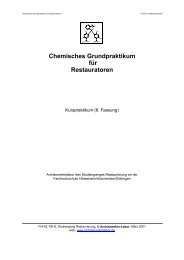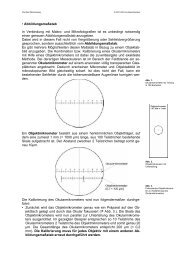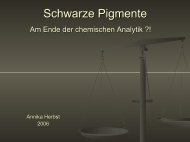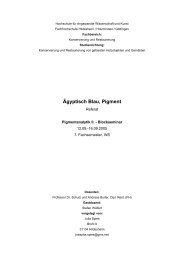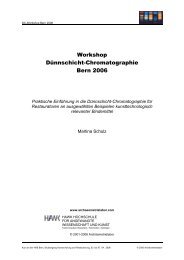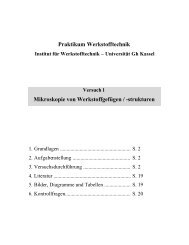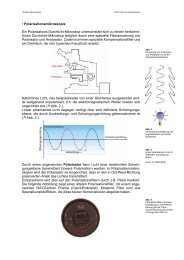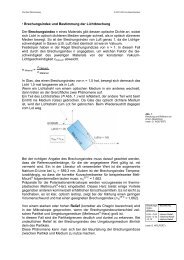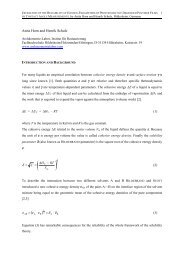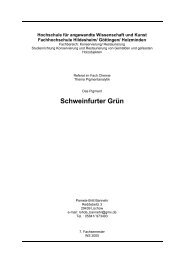Henrik Schulz* and Anita Horn, Archäomertrie-Labor der HAWK ...
Henrik Schulz* and Anita Horn, Archäomertrie-Labor der HAWK ...
Henrik Schulz* and Anita Horn, Archäomertrie-Labor der HAWK ...
Create successful ePaper yourself
Turn your PDF publications into a flip-book with our unique Google optimized e-Paper software.
Manuscript, H. Schulz <strong>and</strong> A. <strong>Horn</strong>, Hildesheim, henrik.schulz@archaeometrielabor.com 6<br />
Case 2:<br />
The same situation like case 1, but now the wooden surface is just treated by plasma (index<br />
“one”, 1). The part of pre-adsorption of water molecules before (π0,V) <strong>and</strong> after (π1,V) the<br />
treatment is different:<br />
π0,V > π1,V<br />
but after wetting the surface with the aqueous test liquid (index “L”) the coverage of water<br />
molecules is the same like that before, i.e. the initial situation stated out in case 1:<br />
π1,LV = π0,V<br />
With the measured contact angle Θ1,V the YOUNG´s equation (4) is actually:<br />
γSV,1 = γS,1 " π1,V <strong>and</strong><br />
γS,1 − π1,V = γSL,1 + γLV⋅cos Θ1,V (4.2)<br />
Case 3:<br />
This case is very similar to case 1, but the initially presence of normal atmosphere (moisten<br />
air, index “V”) is even replaced by n-hexane as outer fluid (index “H”). Both spreading<br />
pressures π0,V <strong>and</strong> π0,H have an effect on the coverage of fluids onto the surface. But the<br />
situation of adsorption before <strong>and</strong> after contact the wooden surface un<strong>der</strong> n-hexane with the<br />
aqueous test liquids remains unchanged <strong>and</strong> the same:<br />
π0,V + π0,H = π0,LV + π0,LH<br />
<strong>and</strong><br />
π0,H = π0,LH<br />
because of<br />
π0,V = π0,LV (see case 1).<br />
Consi<strong>der</strong>ing the strong polar surface of wood (hydroxy groups) we can expect<br />
π0,V > π0,H<br />
The YOUNG term is very similar to case 1:<br />
γSH,0 = γS,0 " (π0,V + π0,H)<br />
<strong>and</strong><br />
γS,0 − (π0,V + π0,H) = γSL,0 + γLH⋅cos Θ0,H (4.3)



